[-> Archives of Dr. mn's Research Works]
The Original Work: March 3, 1989 (not published elsewhere)
Problems and Solutions in Developing
the User Interface of Medical Information Systems
Masahiro NISHIBORI and Michio HAGIHARA
Clinical Laboratory, Tokyo Medical and Dental University, Hospital of Medical School
1-5-45, Yushima, Bunkyo-ku, Tokyo 113, Japan
online edition<Last updated, Dec. 8, 1995>
Purpose: We studied a new method for developing user-friendly medical information systems.
Method: We devised a new method characterized by intensive system analysis and use of prototypes. Using this method, we tried to develop an on-line computer system used by medical technologists.
Results: Our new method showed outstanding effects. These effects included a decrease in difficulty in using a system, an improvement in performance of a system, and a decrease in time for developing a system.
Conclusion: Our new method for developing the medical information system is excellent.
(Keywords: user interface, medical information system, prototyping)
Contents
1. Introduction
2. Background
3. Method
4. Results
4.1. Participants in the development
4.2. System analysis
4.3. Designing the system
4.4. Time for the development
4.5. Performance of the system
5. Lessons Learned
6. Future Plans
REFERENCE
Recently, many computer systems so-called medical information systems are being developed. But medical stuffs, especially doctors and nurses, are not always satisfied with them, rather, even tend to hesitate to use them. For example, total hospital information systems are the most common medical information systems in Japan, and they have greatly reduced labor of medical clerks, but medical stuffs, who usually input or retrieve data by themselves, often feel difficult to learn and to use these systems, and their productivity rather decreased than before [1][2][3][4][5]. As for laboratory information systems, medical technologists often complain that these systems take a lot of time to be developed and have less performance than they have expected [6]. And no reliable method for developing the computer systems free from these problems have been established yet.
To solve these problems, we devised a new method for developing computer systems based on our experience in management of the laboratory information system of the clinical laboratory of the hospital of our university [6], using ideas about the user interface of the computer systems [7][8]. This paper describes our results and proposes a new method for developing user-friendly medical information systems.
The procedure of an ordinary method for developing computer systems generally used is the following: 1) hearings from the users about their needs, 2) system analysis, 3) system design, 4) approval of a system plan in written form by the users, 5) development of the application programs, 6) debugging and verifying performance of the developed system, 7) documentation on the system, 8) running and maintenance of the system [9].
As for the medical information systems, the users of which include doctors, nurses, pharmacists and medical technologists, have the following common characteristics:
a) The users know little about computer systems and what computer systems can do. In Japan, they are unfamiliar with even keyboards because they seldom use typewriters.
b) The users have little time to learn and to use these systems because they have a lot of work.
c) The users require these systems to have the complicated functions, the flexibility to accept a lot of exceptions and the various decisions made by them, and short response time. Moreover, the users have different requirements according to their respective specialities.
Because of a) and c), neither users nor developers can take all of these requirements into consideration completely when they design these computer systems. And because of a) and b), the user interface of these computer systems must be easy to learn and to use, in other words, user-friendly. We think that neither users nor developers of these systems understand these points and most of the problems are caused from here.
Our modification of the ordinary method for developing computer systems is the following:
1) Our system analysis includes intensive investigation and analysis of the sources of the requirements of the users.
2) We make prototypes of the user interface of the system after system analysis, and also make sure of the requirements of the users showing them the prototypes.
Using this method, we started to develop one of the on-line computer systems. They are elements of the laboratory information system under our management that makes worksheets for sequential analysis of specimens, collects the values measured with analyzers and manually, and makes printed reports for the doctors. And the on-line computer system connects an analyzer to the host computer and the medical technologists manipulate it through an intelligent terminal with a display and a keyboard.
As a control, we made a commercial software developer start simultaneously to develop a system that has the same purpose and the same hardwares using a generally used method as described previously. Then we examined the progress of the development of each system and the improvement of the user interface obtained by our new method.
4.1. Participants in the development
Three personnel, one of the authors as a project leader and two medical technologists who are trained to manage the laboratory information system, were able to participate in the development by our method without any trouble of our routine work. We couldn't exactly know how many personnel of the commercial software developer participated in the development by an ordinary method.
4.2. System analysis
We revealed the requirements of the users through the system analysis. They are the following:
1) The essential functions required
(1-1) It receives measured values from an analyzer, makes an temporary backup of them, transforms them into an appropriate format, and put them into the database of the host computer.
(1-2) It enables the medical technologists to review the measured values shown on the display to find incorrect values, for example, values that are measured when the analyzer runs improperly and are higher or lower than the analyzer is expected, and to correct them with the keyboard.
2) The essential factors that influence the performance of the user interface of the system
(2-1) The less knowledge and information the users must keep in mind when they use the system and the simpler the way of the operation is, the more comfortable they feel and the fewer mistakes they make.
(2-2) The shortest response time is required when the users order the system to show them the measured values to review and, if necessary, to correct them.
4.3. Designing the system
To fill (2-1) of 4.2., we used the following technics and made sure of their effects showing the prototype to the users:
a) We constructed the tree structure of the command menu so that the users can select immediately the commands that they use frequently.
b) When the users select an option with a command menu displayed, we made the selected option displayed with inverted characters and enabled the users to move among options with upper and lower arrow keys, instead of making them select a numeric character that heads the option with the numeric keys.
c) We made the system tell the users what they can do next, how they can do it, and what problem may results from their operation with enough messages displayed on the appropriate occasion.
d) We made the number of the measured values clearly displayed at a time as large as possible to reduce the frequency of changing displayed data.
e) When the users correct a wrong value, we made the selected value displayed with inverted characters, enabled the users to move among values with upper, lower, left and right arrow keys, instead of making them select a number that heads the value with the numeric keys, and made the new value input by the users with the numeric keys displayed over the previous one.
To fill (2-2) of 4.2., we made all raw data kept in the fixed disk of the host computer, which has a short access time, instead of in the flexible disk of the intelligent terminal.
4.4. Time for the development
Using our method, we could almost finish the development within 3 months. On the other hand, using an ordinary method, the commercial software developer needed 4 months to make a system plan in written form to obtain approval of the user, then we made him stop his work there. The reason that we needed much less time than the commercial software developer is the following:
1) Improvement of the prototype through hearings from the users to fill their requirements consequently included debugging and verifying performance of the developed prototype.
2) Because the application programs of the prototype were planned to be included in the system as it is, only the application programs that constitute other parts of the system were left to be developed when the prototype filled the requirements of the users.
4.5. Performance of the system
The medical technologists who use the on-line computer system judged that the system developed by us [Fig. 1] is much easier to learn and to use, and also its total performance is much better, not only than the system written in the plan designed by the commercial software developer, but also than any other on-line computer system that was developed by ordinary methods [Fig. 2] and they had used, and consequently it fills their requirements almost completely.
Fig. 1 User interface of the on-line system developed by our method.
(a)
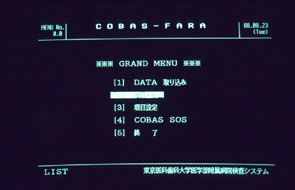
(b)
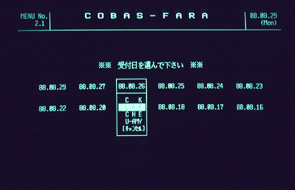
(c)

(d)

(e)
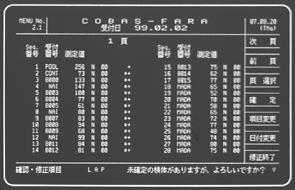
(f)
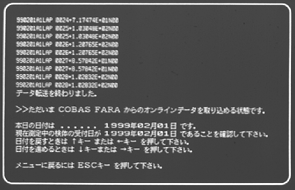
(g)
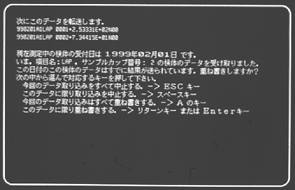
(h)
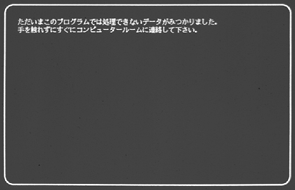
Fig. 2 User interface of the on-line system developed by a conventional method.
(a) main menu
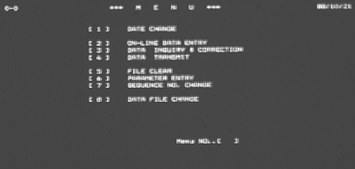
(b) data editor

The procedure of our method may be complicated and it is difficult to predict how long does it take to improve the prototype until the requirements of the users are filled, but by our method the users can see with a prototype, instead of with a plan in written form, what the system can do, how it is easy or difficult to learn and to use, and how the user interface of it is improved through hearings.
In fact, our new method showed outstanding effects. These effects included a reduction of difficulty in using a system, improvements in performance of a system, and consequently an increase in productivity of users, moreover, a decrease in time for developing a system. These results confirm our idea. Therefore, we conclude that intensive system analysis and use of prototypes have a great effect on the development of user-friendly medical information systems without any increase in costs.
We think that following points require further study:
1) Only two computer systems (one of them is not reported here but we also made a great success about it) have been developed by our new method. We will try to develop more computer systems.
2) Computer systems developed by our methods may have various ways of operations and application programs according to needs of respective users. Therefore running and maintenance of them will become complicated when the number of them increased. We will try to modify our method for developing not only user-friendly but also standardized computer systems.
3) Only computer systems used by medical technologists were developed by our new method. We will try to develop computer systems used by doctors, nurses and pharmacists, for example, a total hospital information system.
- [1]
- Isoroku Kato, et al., On-line Information System of Sizuoka General Hospital; Clinical lab module with on-line order entry, local processing and newly designed menu, Proceedings of the 6th Joint Conference on Medical Informatics, (1986) 265.
- [2]
- Yumiko Uto, et al., Evaluation of Hospital Information System by Nurses, Proceedings of the 6th Joint Conference on Medical Informatics, (1986) 489.
- [3]
- Harumi Oomiya, et al., The present condition and Evaluation of The Hospital Information Total System in the KITASATO UNIVERSITY EAST HOSPITAL, Proceedings of the 7th Joint Conference on Medical Informatics, (1987) 7.
- [4]
- Yutaka Ando, et al., Characteristics and evaluation of ordering system including prescriptions, laboratory examinations and reservations, Proceedings of the 8th Joint Conference on Medical Informatics, (1988) 41.
- [5]
- Junya Sakai, et al., Survey of Practical Use by Questionnaires, Proceedings of the 8th Joint Conference on Medical Informatics, (1988) 849.
- [6]
- Masahiro Nishibori, et al., Ideal User Interface for Medical Information Systems; An Approach toward User Friendly Hospital Information Systems, Proceedings of the 8th Joint Conference on Medical Informatics, (1988) 305. (abstract in English available)
- [7]
- Ben Shneiderman, Designing the User Interface (translated into Japanese), Nikkei Business Publications, Inc. (1987)
- [8]
- Apple Computer, Inc., Inside Macintosh Volume I, Addison-Wesley Publishing Company, Inc. (1986)
- [9]
- Hiroshi Hino, et al., Jouhou Shisutemu no Keikaku, Sekkei Jitsumu (Planning and Designing the Information System), Nikkei Business Publications, Inc. (1987)
[-> Archives of Dr. mn's Research Works]

















